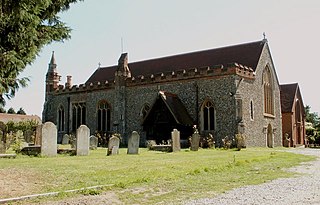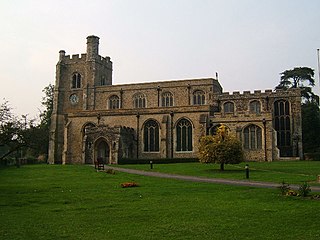
Sir Walter Mildmay was a statesman who served as Chancellor of the Exchequer to Queen Elizabeth I, and founded Emmanuel College, Cambridge.

Samuel Harsnett, born Samuel Halsnoth, was an English writer on religion and Archbishop of York from 1629.

Aldermaston Court is a country house and private park built in the Victorian era for Daniel Higford Davall Burr with incorporations from a Stuart house. It is south-east of the village nucleus of Aldermaston in the English county of Berkshire. The predecessor manor house became a mansion from the wealth of its land and from assistance to Charles I during the English Civil War under ownership of the Forster baronets of Aldermaston after which the estate has alternated between the names Aldermaston Park and Aldermaston Manor.

Ingatestone is a village and former civil parish in Essex, England, with a population of 5,409 inhabitants according to the 2021 census. Just north lies the village of Fryerning, the two now forming the parish of Ingatestone and Fryerning, in the Borough of Brentwood. Ingatestone lies in the Metropolitan Green Belt 20 miles north-east of London. Its built-up area straddles the A12 trunk road and the Great Eastern Main Railway Line.

Hatfield Peverel is a village and civil parish at the centre of Essex, England. It is located 6 miles (10 km) north-east from Chelmsford, the nearest large city, to which it is connected by road and rail. The parish includes the hamlets of Nounsley and Mowden. Hatfield means a 'heathery space in the forest'; Peverel refers to William Peverel, the Norman knight granted lands in the area by William the Conqueror after the Norman invasion of 1066. Sited on high ground east of the River Ter, between Boreham and Witham on the A12, it is situated in the southern extremity of the Braintree District Council area. In 2020, the built-up area subdivision had an estimated population of 3,226. In 2011, the built-up area which includes Nounsley had a population of 3,950 and the parish had a population of 4,376.

Withington is a village and parish in Shropshire, England.

Alresford is a village and electoral ward in Essex, England. It is centred 9 km (5.6 mi) southeast of Colchester and is 39 km (24 mi) northeast from the county town of Chelmsford. The village and its civil parish are the district of Tendring. The local primary school is Alresford Primary School and the village has a pre-school and church. Alresford won the Essex Village of the year competition in 2012 and tied for first place for another Essex Village of the Year award in 2019.

Arlington was a manor, and is a village and civil parish in the North Devon district of Devon in England. The parish includes the villages of Arlington and Arlington Beccott. The population of the parish is 98.

Sunningwell is a village and civil parish about 3+1⁄2 miles (6 km) south of Oxford, England. The parish includes the village of Bayworth and the eastern part of Boars Hill. The parish was part of Berkshire until the 1974 boundary changes transferred it to Oxfordshire. The 2011 Census recorded the parish population as 904.

Pampisford is a village, south of Cambridge, on the A505 road near Sawston, Cambridgeshire, England.

Wittersham is a small village and civil parish in the borough of Ashford in Kent, England. It is part of the Isle of Oxney.

Tetsworth is a village and civil parish about 3 miles (5 km) south of Thame in Oxfordshire. Its Parish Council is made up of six elected Councillors. The estimated population in 2018 was 752 persons. According to the Council, business included the Zioxi educational furniture plant, the Swan antiques centre and some nearby equestrian and agricultural enterprises. The village no longer had a post office or many retail operations, but retained its "church, primary school, village hall, sports on the village green, and village pub and restaurant".

Sible Hedingham is a large village and civil parish in the Colne Valley in the Braintree District of Essex, in England. It has a population of 3,994 according to the 2011 census. Sible Hedingham lies in the northern corner of Essex, close to both the Suffolk and Cambridgeshire borders. The village covers some 2,123 hectares.

Brentwood is a town in Essex, England, in the London commuter belt 20 miles north-east of Charing Cross and close to the M25 motorway. The population of the built-up area was 55,340 in 2021.

The Grove is a large hotel in Hertfordshire, England, with a 300–acre (1.2 km2) private park next to the River Gade and the Grand Union Canal. It touches on its north-west corner the M25 motorway and remains a small part in Watford. The estate is situated within three different settlements; most of the land and all of the mansion itself are in the civil parish of Sarratt, and also in the ecclesiastical parish of Langleybury, while the estate lies within the post town of Rickmansworth.

Widford is an area of Chelmsford and former civil parish, in the City of Chelmsford district in the county of Essex, England. It is approximately 1.5 miles (2.4 km) south-south-west of the city's railway station. It encloses a mixed residential, industrial and rural area south of the River Can, east of the River Wid and mostly to the west of the Great Eastern Main Line. In 1931 the parish had a population of 457.

Bocking is a suburban village on the northern side of Braintree, in Essex, England.

The Church of St Nicholas, Charlwood, is the parish church of Charlwood, Surrey, England. With a 12th-century tower and nave section and examples of 13th to 15th century art, fixtures and architecture, it is a Grade I listed building.

Marks was a manor house located near Marks Gate at the northern tip of the London Borough of Barking and Dagenham in London, England, the house standing on what is now Warren Hall Farm, about two miles west of Romford. The name Marks is believed to have been derived from the de Merk family who built the original manor in the 14th century. The manor house was demolished in 1808.

Joan Prentice or Joan Prentis was an Englishwoman executed after being accused of witchcraft with Joan Cunny and Joan Upney in Chelmsford in Essex in 1589.





















